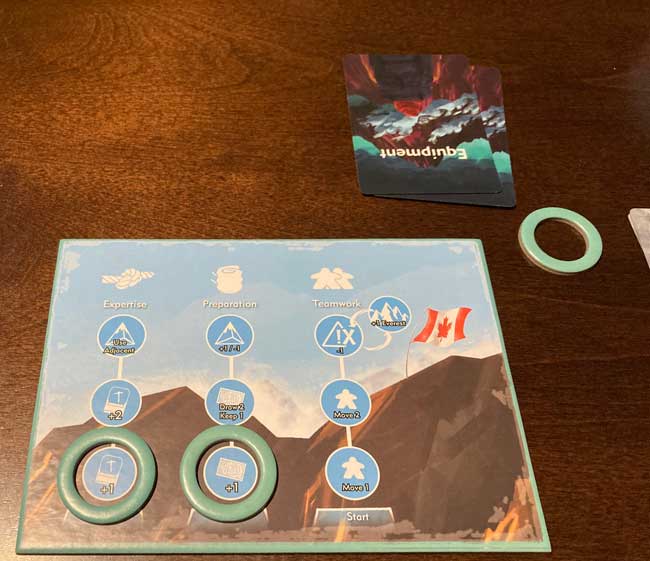7 Summits is a game published by Deep Water Games. The premise of the game is for players to take on the role of world class mountain climbers working to climb to the summits of the tallest mountains in the world. Once each mountain peak has been summited by at least one player, the game end is triggered and the player with the most points is declared the winner.
This post is broken into the following 3 sections, feel free to jump directly to one:
- General summary - consisting of information about overall enjoyment, theme, replayability, and upgrades
- Complexity - consisting of information about the rulebook, setup, player turns, and overall learning curve
- Player turns - consisting of game type, game flow, rule you are likely to miss, and favorite aspect
General Summary
Number of players we had: 4
Our play time (not including setup): 55 minutes
Overall enjoyment

Overall our group enjoyed playing this game. It is a good example of a family/starter game because it is easy to teach and learn, can be played in less than an hour, and setup and breakdown are also quick. What makes 7 Summits more complex than some starter games is that the game requires strategy in addition to having drafting and a press-your-luck element.
Each round the first player rolls all the mountain climbing 4-sided dice. These results are what each player can choose from on their turn that round. This means each round has a high level of unpredictability and players are constantly adapting and finding new ways to move their game forward. The consistent challenge is something we like about this game.
If we had to pick something that frustrated us about this game it would be that the 4-sided dice can be really hard to pick up for anyone with dexterity issues or larger hands.
Theme

The mountain climbing theme is cute. The game board is small but it really doesn't need to be larger. The player boards are also compact and the symbols across the equipment and mission cards, player boards and game boards all help fulfill the theme. For example, a carabiner, tent and rope, are the symbols that relate to discovery tokens and the skills of your climber.
Another nice thing about the theme is the two pages at the end of the rule book discussing each of the mountains in the game. These include the name, elevation, location, and some general information about what makes these summits so tough to conquer.
Replayability

Each mission card relates to a certain summit, of which there are only seven, so there is only so many different combinations of possible missions. Luckily, there are several things that increase the replayability of the game. These include:
- Every round the colored mountain climbing dice are rolled and paired with their corresponding mountain. This means the available dice values are completely unpredictable. At times you might get lucky and get the exact number of movements to reach a desired space on the mountain, and other times you might wait several rounds and still not get the number you were hoping for. It's also quite possible someone else used the climbing dice you wanted before you could!
- Early on in the game, when your expertise, preparation and teamwork skills are low, finding a good play each round can be challenging. As your skills increase, and you gain the benefits associated with each skill level, many goals become easier to obtain. However, the game is also getting easier for other climbers so all players still need to pay close attention to other player's progress.
- Twelve of fourteen discovery tokens are used each game and they are randomly placed on the mountains. No player knows what benefits will be provided until they are able to collect the token and each token can only be collected by a single player.
Upgrades
To my knowledge there are no upgrades for this game.
Complexity
Rule book
The rule book is easy to follow and well organized. Each section has images and/or examples that make it easy to understand how the game works and what each symbol means. Additionally, the back page is a summary of all of the symbols used in the game and since the rule book is small, it easily fits on the table as a reference for players.
Setup
This game takes about 5-10 minutes to set up. Setup is not very complex and the rule book has a page dedicated to the steps, along with numbered images that correspond to each step. After setting up some cards, tokens and distributing player boards and meeples, you are ready to play.

Turns
Player turns are quick because each player has only one action: climbing up one of the seven mountains. This is accomplished by choosing one of the pre-rolled dice at the bottom of any mountain and moving your meeple up that mountain the number of spaces on the mountain climbing die. Players are able to gain any potential benefits listed on a space only when they end their movement on that space.
Once a player has finished moving, they can choose to stop climbing, or they can press their luck by rolling the 4-sided movement die with a risk die. The risk die have three possible options: keep climbing, subtract 1-2 spaces from the number on the movement die, and avalanche which drops your climber to the bottom of the mountain where you must begin again.
Each player is climbing mountains working to get to the top of every summit they can. Reaching a summit before other players is worth more points. This means each player is working towards the same goals, but they are also competing to get there faster and will sometimes need to change their plans so they can reach a summit before other players.
Additionally, players can use any unused climbing die to climb Mount Everest, as it does not have a dedicated die. If players choose to press their luck on Mount Everest, they must roll the risk die twice.
Lastly, if a player cannot use any of the available climbing die, they choose any available die and move it to the top of its corresponding mountain to acquire an equipment card which will help them on future turns.
Overall learning curve
The overall learning curve of this game is low. The game can be learned in 10-15 minutes and one of the nice things about it is it begins with simple rules and gets more complex as players are able to increase their skills and unlock greater abilities. Additional skills provide climbers with the ability to use a mountain die from a neighboring mountain, adjust mountain die by +1 or -1, to adjust the result of a risk die and much more.
Player Turns
Play type
7 Summits is a competitive and symmetrical dice-rolling, drafting, press-your-luck game. Each round the mountain climbing 4-sided dice are rolled by the first player for that round. These are then matched with their corresponding mountains. One at a time players choose one of the dice below a mountain to move their climber up that mountain the number of spaces on the die. Depending upon the number of players in the game, players may only get one die per round. This means you really need to pay close attention to how each die can move your game forward.

Game flow
The flow of this game is pretty quick because players really only have one action: climbing mountains. Each round players are presented with different possibilities based on the values of the mountain climbing dice. However, players never know which dice will still be available when their turn arrives, or what other players may do on their turns. Still, because climbing is the main focus, rounds pass pretty quickly.
Rule you are likely to forget/miss
The rules you are likely to forget or miss is that you can use any amount of equipment cards on your turn and that you can press on when climbing a mountain. It is easy to move up the mountain to the space you wanted and forget you can keep climbing if you want to, though this comes at some risk.
Favorite aspect
Our favorite aspect of this game is how acquiring teamwork skills, by landing on the same space as another climber, can help both climbers advance their game even though this is a competitive game. We also like that the dice are rolled once at the beginning of the round and everyone knows what they have to choose from the entire round.
In summary, 7 Summits is a fun starter game for anyone who likes the theme, enjoys dice rolling or drafting in a game, or who wants to learn a new game that requires some planning as well as some press-your-luck! 7 Summits has a small footprint, fits easily on game shelves, and would also travel well. If you are looking for a game that can be learned in less than 20 minutes but is also challenging, this might be the game for you!


